The Samsung 950 Pro PCIe SSD Review (256GB and 512GB)
by Billy Tallis on October 22, 2015 10:55 AM ESTSequential Write Performance
The sequential write test isn't limited to a small span of the disk, as that usually doesn't make a difference for this performance metric. As always, our averages are of the lower queue depths, but scaling to higher queue depths is also investigated. Bulk file copies and recording uncompressed video are the kind of uses that depend on sequential write performance.
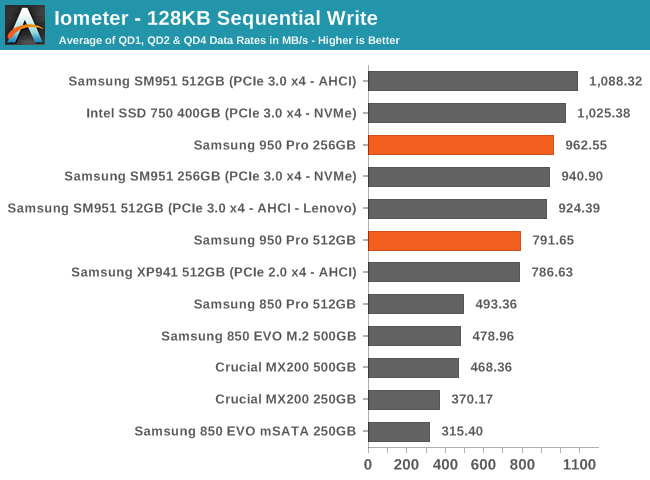
Even at low queue depths, most SSDs can spread a sequential write workload across multiple channels to achieve very high throughput. All of the PCIe drives perform well above the SATA limit but nowhere near the capacity of the PCIe links. The 512GB 950 Pro seems to again be encountering thermal throttling, and more severely than the SM951s we tested.
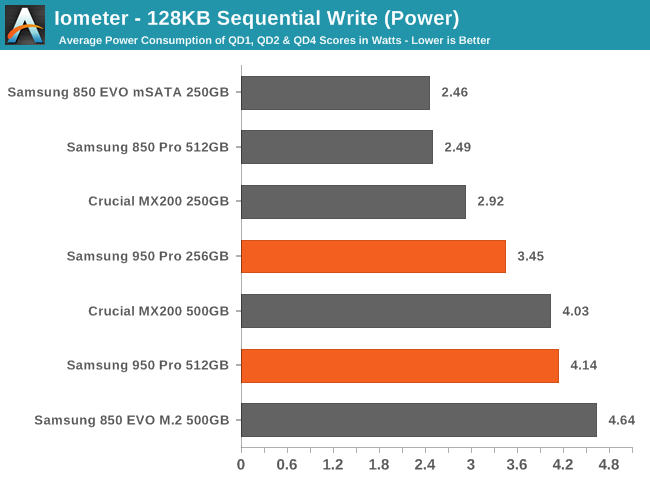
The average power consumption for writes is still on the high side by SATA standards, but is quite reasonable in light of the performance achieved.
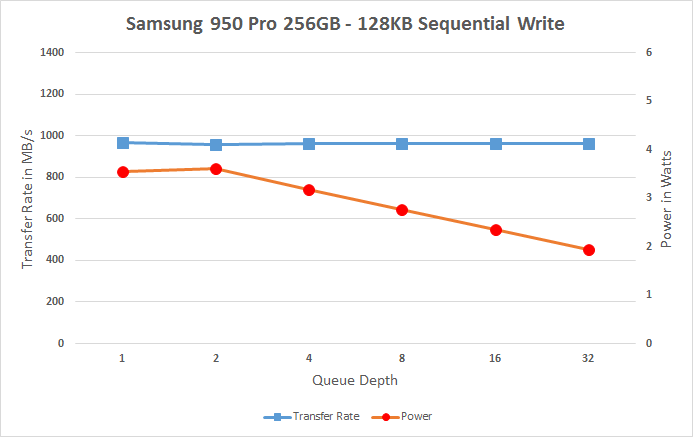 |
|||||||||
Performance across the sequential write test is mostly constant, but power isn't. The declines in power consumption in spite of increased queue depth are again most likely an artifact of whatever background processing is going on in the drive. On SATA drives, it's usually obvious from looking at the power meter when a drive has completed background processing and is truly idle and ready to run the next test, but with the lack of working power management for PCIe drives on our testbed I'm not so sure here. Overall it's probably a good sign that the drives were able to maintain high performance in spite of whatever else was going on, but given more cooling the 512GB can probably do much better.
Sequential Read Performance
Just like the random read test, sequential reads are tested across the span of a full drive and a representative sample of queue depths. Most operations involving large files (typically images and videos) fall under this test's purveiw, but streaming or playing even the highest resolution videos won't be a challenge for any of these drives. Copying files to another SSD or loading a new level in a video game would be more likely to show noticeable difference from better performance here.
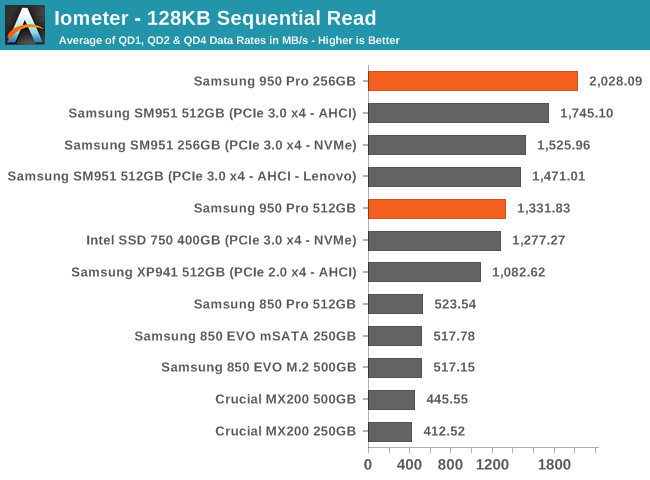
The sequential read performance is probably the best showcase of what the PCIe 3.0 x4 interface can do. The 256GB 950 Pro attains over half of the link speed, but the 512GB is again bogged down by something—relatively speaking, since it's still more than twice the speed of SATA and faster than even the Intel SSD 750. It's possible that the 950 Pro isn't faithfully implementing the secure form of the NVMe format command and some lingering fragmentation is preventing the 512GB drive from performing as specified. Read operations require less power to be supplied to the flash chip than for writes, but if the thermal throttling is all in the controller it could be showing up here as well.
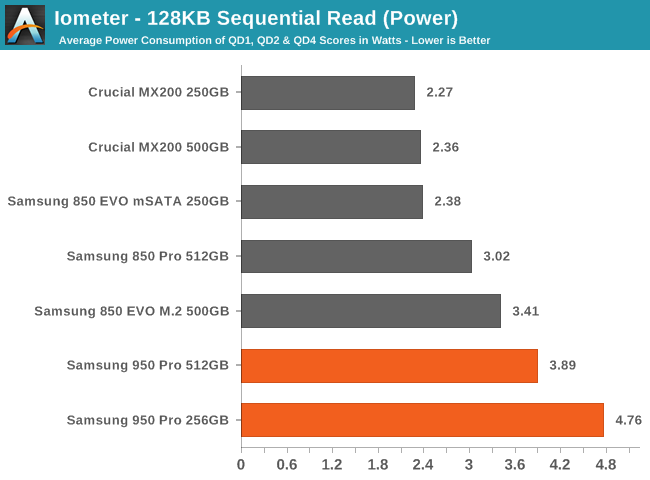
Relative to each other, the 950 Pro's power consumption is in line with the performance they're demonstrating, and proportionally much better than the SATA drives.
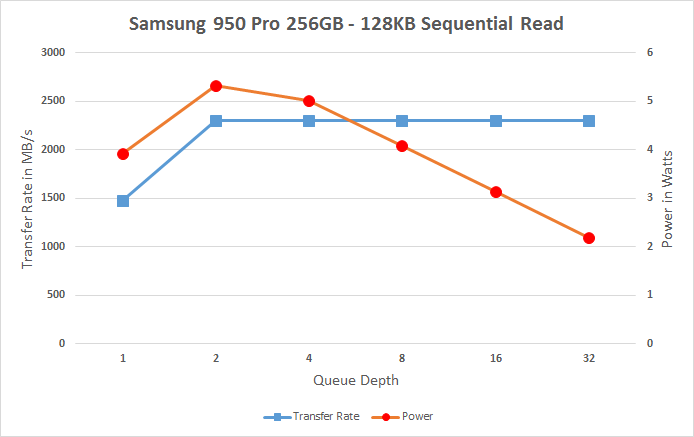 |
|||||||||
At queue depth 1, both of the 950 drives are performing similarly. When moving to higher queue depths the 256GB immediately hits 104% of its rated speed, but the 512GB doesn't improve any. (It's worth noting the differing scale for Transfer Rate in the graphs above.) The puzzling decline in power consumption at higher queue depths shows up again on the 256GB and definitely warrants deeper investigation.










142 Comments
View All Comments
Der2 - Thursday, October 22, 2015 - link
Wow. The 950. A BEAST in the performance SHEETS.ddriver - Thursday, October 22, 2015 - link
Sequential performance is very good, but I wonder how come random access shows to significant improvements.dsumanik - Thursday, October 22, 2015 - link
Your system is only as fast as the slowest component.Honestly, ever since the original x-25 the only performance metric I've found to have a real world impact on system performance (aside from large file transfers) with regards to boot times, games, and applications is the random write speed of a drive.
If a drive has solid sustained random write speed, your system will seem to be much more responsive in most of my usage scenarios.
950 pro kind of failed to impress in this dept as far as I'm concerned. While i am glad to see the technology moving in this direction, I was really looking for a generational leap here with this product, which didn't seem to happen, at least not across the board.
Unfortunately I think i will hold off on any purchases until i see the technology mature another generation or two, but hey if you are a water-cooling company, there is a market opportunity for you here.
Looks like until some further die shrinks happen nvme is going to be HOT.
AnnonymousCoward - Thursday, October 22, 2015 - link
> Your system is only as fast as the slowest component.Uhh no. Each component serves a different purpose.
cdillon - Thursday, October 22, 2015 - link
>> > Your system is only as fast as the slowest component.>Uhh no. Each component serves a different purpose.
Memory, CPU, and I/O resources need to be balanced if you want to reach maximum utilization for a given workload. See "Amdahl's Law". Saying that it's "only as fast as the slowest component" may be a gross over-simplification, but it's not entirely wrong.
xenol - Wednesday, November 4, 2015 - link
It still highly depends on the application. If my workload is purely CPU based, then all I have to do is get the best CPU.I mean, for a jack-of-all-trades computer, sure. But I find that sort of computer silly.
xype - Monday, October 26, 2015 - link
Your response makes no sense.III-V - Thursday, October 22, 2015 - link
I find it odd that random access and IOPS haven't improved. Power consumption has gone up too.I'm excited for PCIe and NVMe going mainstream, but I'm concerned the kinks haven't quite been ironed out yet. Still, at the end of the day, if I were building a computer today with all new parts, this would surely be what I'd put in it. Er, well maybe -- Samsung's reliability hasn't been great as of late.
Solandri - Thursday, October 22, 2015 - link
SSD speed increases come mostly from increased parallelism. You divide up the the 10 MB file into 32 chunks and write them simultaneously, instead of 16 chunks.Random access benchmarks are typically done with the smallest possible chunk (4k) thus eliminating any benefits from parallel processing. The Anandtech benchmarks are a bit deceptive because they average QD=1, 2, 4 (queue depth of 1, 2, and 4 parallel data read/writes). But at least the graphs show the speed at each QD. You can see the 4k random read speed at QD=1 is the same as most SATA SSDs.
It's interesting the 4k random write speeds have improved substantially (30 MB/s read, 70 MB/s write is typical in SATA SSDs). I'd be interested in an in-depth Anandtech feature delving into why reads seem to be stuck at below 50 MB/s, while writes are approaching 200 MB/s. Is there a RAM write-cache on the SSD and the drive is "cheating" by reporting the data as written when it's only been queued in the cache? Whereas reads still have to wait for completion of the measurement of the voltage on the individual NAND cells?
ddriver - Thursday, October 22, 2015 - link
It is likely samsung is holding random access back artificially, so that they don't cannibalize their enterprise market. A simple software change, a rebrand and you can sell the same hardware at much higher profit margins.